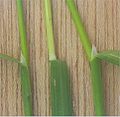Poa annua
| Poa annua | |
|---|---|

| |
| Scientific classification | |
| Kingdom: | Plantae |
| Clade: | Tracheophytes |
| Clade: | Angiosperms |
| Clade: | Monocots |
| Clade: | Commelinids |
| Order: | Poales |
| Family: | Poaceae |
| Subfamily: | Pooideae |
| Genus: | Poa |
| Species: | P. annua
|
| Binomial name | |
| Poa annua | |
Poa annua, or annual meadow grass (known in America more commonly as annual bluegrass or simply poa), is a widespread low-growing turfgrass in temperate climates. Notwithstanding the reference to annual plant in its name, perennial bio-types do exist.[citation needed] This grass may have originated as a hybrid between Poa supina and Poa infirma.[1]
Description[]
It has a slightly creeping, fibrous, rootstock. The stem grows from 15–25 cm (6-10 in.) high. It is slightly flattened, due to being folded rather than rolled.
The panicle is open and triangular shaped, 5 to 7.5 cm (2 to 3 in.) long. The spikelets are stalked, awnless, 1 to 2 cm (3/8 to 3/4 in.) long when flowering, and loosely arranged on delicate paired or spreading branches. Sometimes they are tinged purple.
The vivid green leaves are short and blunt at the tips, shaped like the prow of a small canoe. They are soft and drooping. Long sheaths clasp the stem. The leaves are smooth above and below, with finely serrated edges. Occasionally the leaves are serrated transversely.
The ligule is pointed and silvery. Compared this to Common Meadowgrass Poa pratensis, which has a squared ligule, and Poa trivialis, which has a pointed, but less silvery ligule.
The leaves are smooth above and below, with finely serrated edges. Occasionally the leaves are serrated transversely.
It is in flower all year around except for severe winters. The seeds ripen and are deposited 8 months of the year. The plant grows rapidly from seed, flowering within 6 weeks, seeding and then dying.[2]
Etymology[]
Poa is derived from the Greek name for a type of fodder grass.[3] Annua is Latin, meaning 'annual' or 'lasting a year'.[3]
Distribution and habitat[]
It is a common weed of cultivation, known in the Americas as annual bluegrass.[4] It occurs as a common constituent of lawns, where it is also often treated as a weed, and grows on waste ground. Many golf putting greens, including the Oakmont Country Club greens, are annual bluegrass,[5] although many courses have converted to creeping bentgrass (Agrostis stolonifera).
It has appeared on King George Island in the Antarctic South Shetland Islands as an invasive species,[6] as well as on Australia's subantarctic Heard and Macquarie Islands.
| Wikimedia Commons has media related to Poa annua. |
| Wikispecies has information related to Poa annua. |

Habit

Ligule is silvery and pointed.

The panicle is open and triangular shaped

Flowers

Stubborn clump of Poa annua on footpath stones
References[]
- ^ Collins pocket guide Grasses, Sedges, Rushes and Ferns. Fitter.R, Fitter.A, Farrer.A. 1995. page 54
- ^ BSBI Description Archived 2011-07-17 at the Wayback Machine retrieved 10 December 2010.
- ^ a b Gledhill, David (2008). "The Names of Plants". Cambridge University Press. ISBN 9780521866453 (hardback), ISBN 9780521685535 (paperback). pp 50, 308
- ^ Ohlendorf, B.; D. W. Cudney; C. L. Elmore; V. A. Gibeault (April 2003). "Annual Bluegrass Management Guidelines--UC IPM". University of California. Retrieved 2007-09-08.
- ^ Dvorchak, Robert (2007-06-13). "Oakmont-inspired Stimpmeter allows USGA to accurately measure speed, consistency of putting surfaces". Pittsburgh Post-Gazette.
- ^ Antarctic ecology: Polar invaders, The Economist, Mar 6th 2012
External links[]
- European Poa Database
- The Observers Book of Grasses, Sedges and Rushes. Frances Rose. pages 38–39
- Kew gardens grass database
- Weeds friend or foe? Sally Roth. pages 86–87
- BSBI Description
- Poa
- Grasses of Europe
- Garden plants of Europe
- Lawn grasses
- Plants described in 1753
- Taxa named by Carl Linnaeus
- Flora of the Antipodes Islands
- Flora of the Auckland Islands
- Flora of Macquarie Island
- Flora of Heard Island and McDonald Islands




